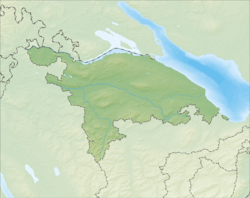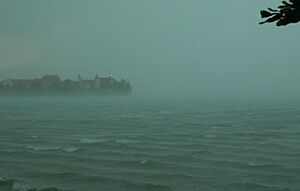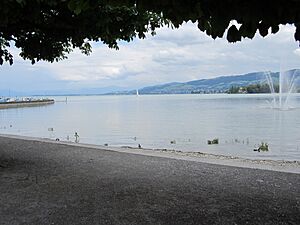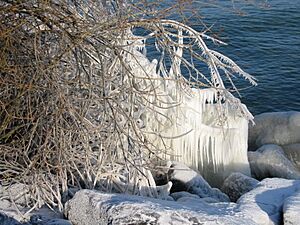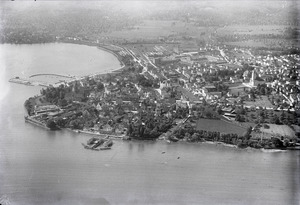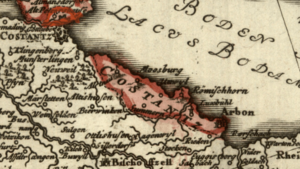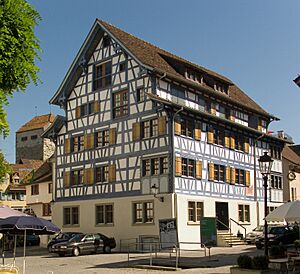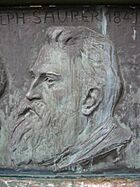Arbon facts for kids
Quick facts for kids
Arbon
|
||
|---|---|---|
 |
||
|
||
| Country | Switzerland | |
| Canton | Thurgau | |
| District | Arbon | |
| Area | ||
| • Total | 6.0 km2 (2.3 sq mi) | |
| Elevation
(Galluskapelle)
|
399 m (1,309 ft) | |
| Population
(Dec 2020 )
|
||
| • Total | 14,950 | |
| • Density | 2,492/km2 (6,450/sq mi) | |
| Demonym(s) | German: Arboner(in) | |
| Postal code |
9320 Arbon, 9320 Frasnacht, 9320 Stachen
|
|
| Localities | Arbon, Frasnacht, Stachen, Schloss, Bergli, Neusätz, Chratzere, Speiserslehn, Scheidweg, Steineloh | |
| Surrounded by | Egnach, Roggwil TG, Berg SG, Steinach, Horn | |
| Twin towns | Langenargen (Germany), Binn (Switzerland) | |
Arbon is a cool historic town in Switzerland. It's located in the canton of Thurgau. Arbon is also the main town of the Arbon district.
You can find Arbon on the southern shore of Lake Constance. It's on a railway line that connects to cities like Konstanz and St. Gallen.
People have lived here for a very long time, going back about 6500 years! The town's castle even has parts from an old Roman fort. Arbon grew into a medieval town in the 1200s.
The main language spoken in Arbon is a local version of Swiss German.
Contents
What is Arbon's Geography Like?
Arbon sits on a small piece of land that sticks out into Lake Constance. This is called a peninsula. It's located between the towns of Romanshorn and Rorschach. To the south, Arbon shares a border with the St. Gallen canton. The city of St. Gallen is the closest big city.
The hills around Arbon are leftover from a huge glacier that was here long ago. Lake Constance forms the border on the northeast and east sides of the town.
Arbon is about 6 square kilometers (2.3 square miles) in size. A big part of this land, about 37.5%, is used for farming. About 55.7% of the land has buildings or roads on it.
Even though Arbon is small, it has six different neighborhoods. The Altstadt (Old Town) is in the middle. It has old medieval buildings and narrow streets. Efforts have been made to reduce car traffic there. Bergli is named after the hill it sits on. The southern part of Arbon, including Neustadt, Bleiche, and Stacherholz, grew as a working-class area during the time of factories.
Two other parts, Stachen and Frasnacht, joined Arbon in 1998. Stachen and Arbon have grown together, but there's still some open land between Frasnacht and the other areas.
How is the Climate in Arbon?
Thanks to Lake Constance, Arbon has mild weather all year. It doesn't get too hot in summer or too cold in winter.
Warm winds from the west bring rain. The warm Föhn wind, which blows over the Alps from the south, also reaches Arbon.
In summer, thunderstorms are common. Arbon has a special warning system for boats on Lake Constance to keep people safe during storms.
In January, the average temperature is around -2 to 0°C (28-32°F). In July, it's about 15 to 18°C (59-64°F). Arbon gets about 80 to 100 cm (31-39 inches) of rain each year.
The winds make Lake Constance a great place for sailing and windsurfing.
In winter, ponds and the lake can freeze. Lake Constance itself froze completely in 1963. This only happens about once every 100 years!
What is Arbon's History?
People have lived on the shores of Lake Constance near Arbon since the Stone Age. Digs have found old stilt houses from the Stone and Bronze Ages. These houses were built on stilts because the ground was swampy.
During Roman times, a place called Bergli was likely a Roman fort. Its high position and view of the lake were important for defense. Remains of late Roman forts have been found there since 1957. The Roman name for Arbon was Arbor Felix, which means happy tree.
In the 600s, Irish monks, including St. Gallus, came to Arbon. They found a small Christian village there. St. Gallus, who founded the famous monastery of St. Gallen, died in Arbon in 627. A fort was built where the castle is now in 720.
For a long time, Arbon belonged to the Prince-Bishopric of Constance. In 1255, the Bishop gave Arbon the right to hold markets and built a city wall. More people moved into the town. From 1262 to 1266, a young duke named Conradin lived in Arbon.
The 1300s saw Arbon grow more, with linen making and other crafts. Sadly, fires in 1390 and 1494 destroyed much of the Old Town.
In 1460, the Swiss took over the Thurgau region. But the Bishops of Constance still controlled Arbon. After a war in 1499, Arbon became part of the Old Swiss Confederacy.
The Arbon Castle we see today was built in 1515 by Bishop Hugo von Hohenlandenberg. The tower is even older, from 993.
In 1525, the Reformation started in Arbon. This caused religious disagreements for many years. By 1712, different faiths were given equal rights in Thurgau.
In the 1700s, the linen and embroidery industries grew. Rich business owners built beautiful houses, like the «Rotes Haus» (Red House) in 1750.
In 1798, French troops came to Switzerland. Arbon became free from the Bishops of Constance. In 1803, it joined the new canton of Thurgau.
The 1800s were a time of big change for Arbon. It became a center for factories and business. This was largely thanks to Franz Saurer. He moved his factory to Arbon in 1863. His company, Adolph Saurer AG, made all kinds of machines and motors. Later, they built trucks and buses. At its busiest, the factory had 5000 workers! Today, it only makes textile machines.
Because of the factories, Arbon's population grew a lot. It went from 660 people in 1844 to over 10,000 by 1900.
Who Lives in Arbon?
Arbon's population grew a lot between 1860 and 1910 because of all the new factories. It even became the biggest city in Thurgau canton. During World War II, some people left because Germany was so close. But after the war, they came back.
Today, Arbon is the third-largest city in the canton. Many people speak German, but Italian and Serbo-Croatian are also common. About 28.9% of the people living in Arbon are from other countries.
What About Religion in Arbon?
Like many places in Thurgau, Arbon has both Roman Catholic and Protestant communities. St. Martin's Church and the Gallus Chapel are Catholic. There is a Protestant church in Bergli. Recently, more Muslim people have moved to Arbon, especially from the Balkans.
How is Education in Arbon?
Switzerland has a good education system. In Arbon, most adults (about 76.1%) have finished high school or gone on to higher education like university.
Arbon has its own primary school district and secondary school district. In the 2008/2009 school year, there were 884 students in primary school. There were also 203 children in kindergarten.
The Stadtbibliothek Arbon is the town's library. In 2008, it had over 1,000 books and other items. It loaned out more than 56,000 items that year!
What is Arbon's Economy Like?
Arbon has a strong economy. In 2007, the unemployment rate was low, at 2.97%.
Many people work in the secondary sector, which includes factories and manufacturing. The old Adolph Saurer AG factory, which used to make trucks, is a big part of Arbon's industrial history. Today, it focuses on textile machinery.
Many people also work in the tertiary sector, which includes services like shops, offices, and healthcare.
How Do People Get Around in Arbon?
Since 1993, Arbon has had an entrance to the A1 motorway. This makes it easy to drive to cities like St. Gallen and Zürich.
Arbon is also on a train line that goes to Rorschach, Romanshorn, and Kreuzlingen. It has two train stations: Arbon and Arbon Seemoosriet. There are also two bus lines that connect Arbon to Amriswil and St. Gallen.
Important Historic Places in Arbon
Several places in Arbon are considered very important national heritage sites:
- The Bleiche (an ancient lake-shore settlement)
- The Gallus Chapel
- The Catholic Church of St Martin
- Arbon Castle and Historical Museum
- The Late-Roman Fortress
The Bleiche sites are part of the Prehistoric Pile dwellings around the Alps which is a UNESCO World Heritage Site. This means they are recognized as very important historical places for the whole world! The entire town of Arbon is also a recognized heritage site.
Notable Residents
Many interesting people have lived in or come from Arbon:
- Saint Gall (around 550 – around 646 in Arbon), a monk who helped spread Christianity.
- Jacques Gerschwiler (1898 in Arbon – 2000), a Swiss figure skater and coach.
- The Saurer family, who were famous for making trucks and buses in Arbon.
- Arnold Gerschwiler (1914 in Arbon — 2003), another Swiss figure skating coach.
- Rolf Järmann (born 1966 in Arbon), a retired professional bicycle racer.
- Felix Baumgartner (born 1969), an Austrian skydiver and daredevil; he lives in Arbon.
- Marcel Bürge (born 1972 in Arbon), a Swiss rifle shooter who competed in the Olympics.
- Giuseppe Perrone (born 1975 in Arbon), a Swiss football player.
- Steve Zampieri (born 1977 in Arbon), a Swiss professional road bicycle racer.
- Andrea Brühlmann (born 1984 in Arbon), a Swiss sport shooter.
- Tunahan Cicek (born 1992 in Arbon), a Swiss professional football player.
Gallery
See also
 In Spanish: Arbon para niños
In Spanish: Arbon para niños




